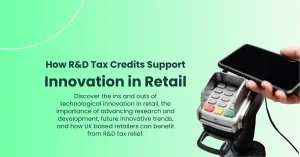The ultimate guide to R&D tax credits in the fashion industry
27 June 2024

The fashion industry is an ever changing marvel that combines art with convenience. But beneath the innovative design is a series of research and development that helps to make garments practical and efficient.
How Fashion Design Companies in the UK Can Benefit from R&D Tax Credits
Here in the UK, such research and development is rewarded by the government, with a fund designed to incentivise innovation across a multitude of industries. Of course, we’re talking about R&D tax credits – the reimbursement of qualifying cost expenditure in relation to research and development.
Today we’re going to explore how this government support can aid in the future of the UK fashion industry and how you can maximise your R&D claim.
What are R&D Tax Credits for Fashion Companies?
Yulan Creative states “The biggest headache for the fashion business today is staying relevant. Relevance comes from investing in fashion innovation, research and development.”
Be it testing under different conditions or the production of a waterproof shoe, the materials that make up your wardrobe have at some point in history been a part of a research and development project. Considering this, you might just say that research and development is crucial in the fashion industry. But just like all innovation, this can come at a hefty cost.
With R&D tax credits however, fashion companies across the UK have the ability to claim a portion of the costs incurred during qualifying activities. While there are many activities that may be eligible for fashion related R&D tax credits, here are a few of the most popular:
- Development of sustainable materials
- Smart and wearable technology/materials
- Innovative advanced manufacturing techniques
- Trend analysis and forecasting
All of these popular eligible activities serve the fashion industry as a whole, but how could they benefit your company?
Benefits of R&D Tax Credits for Fashion Companies
Given the fact that fashion performs on a cyclical basis, there is an increased burden on fashion brands to provide new and innovative garments that challenge competitors – a practice that can become increasingly costly given the constant demand for something new and exciting.
This is what makes the R&D tax credit scheme so inviting to UK based fashion businesses, as the scheme has the ability to greatly reduce the financial burden of research and development.
These financial savings gained by R&D incentives actually encourage innovation while giving companies a competitive advantage without forcing them to shoulder colossal risks.
Question is though, are your fashion related research and development projects eligible for R&D tax incentives?
Eligibility Criteria for R&D Tax Credits in Fashion
Under HMRC guidelines, research and development is a project or activity which aims to better improve an industry via a scientific or technological advancement. In relation to the fashion industry, it’s advised that these projects should set out to overcome a technological or scientific uncertainty that cannot easily be solved by experts in the field.
Now we’ve already touched base on what may constitute qualifying projects in relation to fashion R&D, but there are some misconceptions about the eligibility process. Here are some of the most common ones:
| Misconception | Fact |
| R&D is only for high-tech companies | R&D can encompass improving upon traditional materials or even to develop new technologies |
| It’s too expensive for small fashion brands | Yes research and development is costly, but with incentives and the opportunity to collaborate with other companies, SMEs can actively participate |
| Results must be immediate | Research and development can be time consuming, and the R&D tax schemes aim to support prolonged projects |
| It’s solely for product innovation | HMRC’s definition of research and development covers products, softwares, and technologies |
Truth is, there are a range of strange rumours that surround R&D taxes, which is why we’re here to simplify the process for you, by providing you expert information – such as how to apply for R&D tax credits.
How can I determine if my work qualifies as R&D for tax credits?
To determine if your work qualifies as R&D for tax credits, check if you:
-
Have carried out qualifying research and development:
- Your work aims to make a scientific or technological advancement.
- Your project seeks to resolve scientific or technological uncertainties.
- The problems you’re solving aren’t easily solved by experts in the field.
- Your project involves systematic work with a clear goal of innovation or improvement.
What expenses are eligible for R&D tax credits?
Eligible expenses & cost for R&D tax credits include:
- Staff Costs:
- Salaries
- Employer’s NIC (National Insurance Contributions)
- Pension contributions
- Reimbursed expenses
- Subcontractors and Freelancers:
- Payments to external workers involved in the R&D project
- Materials and Consumables:
- Heat
- Light
- Power
- Materials used up or transformed by the R&D process
How to Apply for R&D Tax Credits in Fashion
Before you’re ready to submit your claim, there are a few documents that you need to compile in preparation for the application process. These documents are intended to provide HMRC with the adequate information regarding your research and development project(s). To give you an insight in what to prepare, the following are the required documents that HMRC ask you to present:
- Project descriptions
- Financial records
- Technical reports
- Supporting documents
Given the amount of specific documents required to make a successful R&D claim, one of the most frequent challenges that businesses face is unpreparedness. Luckily there’s a two-step process that allows you to avoid such a fate, and it goes as follows:
- Keep records throughout each stage of your R&D project
- Work with an R&D specialist to ensure correct documentation is present
Considering HMRC actually recommend you work with a specialist throughout your claims process, your claim becomes a simple case of keeping tabs on your paperwork and calculating your finances. The latter of which can seem a little daunting, so let’s break it down.
Calculation of R&D Tax Credits for Fashion Companies
If your accounting period ends prior to April 1st 2024, then calculating your R&D tax credits is dependent on the size of your company and your annual revenue. This is due to the fact that there are two separate R&D tax credit schemes – one of which is designed specifically for small and medium-sized enterprises (SMEs). If your fashion business has fewer than 500 employees and a turnover of under €100,000 then you will fall under the SME R&D tax credits scheme.
If your company has more employees or a higher turnover but is participating in industry based research and development, you may be eligible for R&D expenditure credit (RDEC).
As of this year the two schemes are merging, meaning if your accounting period ends after April 1st 2024, you simply need to focus on the qualifying costs.
Qualifying Costs
Keeping in mind that your project must aim to scientifically or technologically advance the fashion industry, the following costs can be claimed in relation to your R&D claim:
| Qualifying Costs | Examples |
| Consumable items | Fuel, materials, power, water |
| Data licensing & cloud computing | Data storage, hardware facilities, operating systems, software platforms |
| Staff costs | Salaries, wages, bonuses, pension fund contributions, NI contributions |
| External worker costs | Up to 100% of relevant worker provider payment |
The combination of all of these costs are what makes up your total expenditure which you will be required to include in your R&D claim. Once you have established your eligible scheme and your total expenditure, you have to establish whether the value of your expenditure puts your research and development project in profit or at a loss. This is the last step before you begin calculating your costs.
Calculating Costs
While there are a variety of methods for calculating the value of your R&D claim, our experts recommend that you use tools and resources aimed at simplifying the process. One of our favourites is an R&D tax credit calculator that helps you to decipher roughly how much your claim could be worth.
Depending on the scope of your research and development activities, you could see a substantial rebate from the R&D tax credit initiative – something that a range of our clients have already experienced.
Case Studies: Success Stories from the Fashion Industry
One of the greatest misconceptions about R&D in the fashion industry is that the project must be specifically aimed at the manufacturing aspect of garments. We’re happy to denounce this myth using one of our success stories!
This client developed a scientific approach to optimise garments for athletes. These items of clothing were developed in order to help athletes to comfortably rehabilitate their muscles while still being able to perform to their maximum potential. With collaborative research alongside industry experts, they developed sportswear designed to mirror movement, allowing the clothing to sit comfortably on the abdomen without applying additional pressure – something that up until their research had never been done.
For this reason, we instantly knew that they had a solid R&D claim. And so our experts at Alexander Clifford jumped into action in order to find and document all qualifying activity, and ensure all R&D qualifying costs were covered. Combining their project with our expertise, the client had a successful payout of £29,971.31 thanks to R&D tax credits.
Why did they choose to work with an R&D tax specialist? Because it’s easy to make mistakes when filing a claim independently.
Common Mistakes to Avoid When Claiming R&D Tax Credits
Given how complicated the information on R&D tax credits can be, it’s incredibly easy to make mistakes. Some of the most common mistakes that fashion businesses make when filing their claims are:
- Misidentifying eligible activities: many businesses have a tendency to include ineligible projects, which could lead to inaccurate claims
- Inadequate documentation: R&D claims involve a variety of documents, and unless you’re working with an expert, it can be easy for some of the vital information to slip your mind
- Overlooking indirect costs: a lot of companies miss out on claiming some of their indirect costs, meaning they heavily underestimate their overall expenditure
- Ignoring small projects: often times, companies have a tendency to overlook smaller qualifying projects in favour of the sole large one, in spite of the fact that they could significantly contribute to their overall R&D expenditure
So how can you avoid these R&D claim blunders?
While there are many ways you could go about preparing, these are the four steps we recommend you take while readying your R&D tax credit claim:
- Asses your projects: take a look at each project and assess whether or not they align with the HMRC’s definition of R&D
- Collect financial records: gather the financial documentation that relate to each of your qualifying projects
- Analyse your expenditure: using the information above, calculate the amount of qualifying expenditure that you have for each project
- Consult an expert: with all of your financial documentation and project breakdowns at hand, contact an R&D specialist who can help you to fill out your claim and file all the necessary documentation
With these tips, you can ensure the accuracy of your claim, without losing any opportunities to claim on other R&D related activities your company may be undergoing. With all this in mind, how can it directly benefit your fashion business?
How Fashion Startups Can Benefit from R&D Tax Credits
By producing financial relief and reducing tax liabilities, fashion businesses are free to invest in new innovative ideas that allow them to position themselves as industry leaders. In particular, R&D tax credits have a great impact on fashion startups that are looking to redefine the fashion world.
Facing unique challenges and intense competition, fashion startups often face the need to quickly adapt to market trends in order to succeed. By providing necessary financial support, the R&D tax incentive is in the position to mitigate such intense pressures, allowing small fashion companies to flourish with revolutionary products and practices.
That’s not to say that these credits won’t benefit more established fashion houses, who also have the ability to forge new trends thanks to this incredible scheme.
Future Trends and Predictions for R&D Tax Credits in Fashion
Similar to seasonal fashion, the world of R&D bears witness to a variety of trends that span across a variety of industries. These can change with the scope of legislation, not to mention how they may affect specific sectors. Given this understanding, let’s take a look at our biggest predictions for fashion R&D:
- Enhanced focus on sustainability: due to a government wide focus on environmentalism, sustainability innovation is set to increase across all industries including fashion
- Digital transformation and automation: with an increase in digital campaigns and commerce, many fashion companies are likely to offset some of their online interaction to new technologies such as AI
- Collaborative innovation: transformations in legislation is expected to encourage companies to collaborate on research and development related projects
- Personalisation and customisation: in a bid to stand out from the crowd, fashion businesses are likely to turn to R&D innovation to provide customer-centric designs
In order to get ahead of these trends, you can begin by investing in sustainable practices and research, adopting digital production and design tools, forming professional partnerships, and even developing personalisation technology. Not only will this proactive approach align with potential legislative transitions, but it will further incentivise fashion industry innovation.
FAQ on Fashion R&D Tax Credits
As R&D tax credits in the fashion industry can be a little tricky, you may have some unanswered questions. Let’s go over some of the most important ones so we can straighten a few things out.
What is R&D in the fashion industry?
R&D in the fashion industry is the undergoing of research and development projects that seek to improve the industry in some way. Be it for the consumer or for the business itself, a company will invest in these projects that will ultimately play a crucial role in the development of new products and the enhancement of new processes.
What are qualifying R&D activities?
Qualifying R&D activities in the fashion industry are the research and development projects that aim to make scientific or technological breakthroughs. Projects exploring design analysis, material development, and even wearable technology can fall into HMRC’s strict definition of R&D activities.
What doesn’t qualify for R&D tax credits?
While R&D tax credits cover more consumable costs, they do not cover capital allowances such as machinery and building costs that may be necessary in your research and development project. There do exist, however, additional schemes that cover R&D capital allowances in order to further reduce the financial burden of innovative activity.
In summary, R&D tax credits are an important factor in the progression of the fashion industry. While its strict rules may make it difficult to navigate the eligibility of your research and development projects, there are expert consultants on hand to aid in your R&D claims – which is where we come in!
The R&D tax credit specialists here at Alexander Clifford make sure to keep up to date with all of the latest developments in HMRC policy to provide you a great service that gives you a cash return on your investments! For more information on how we can help you with your R&D claim, fill in the contact form below.







